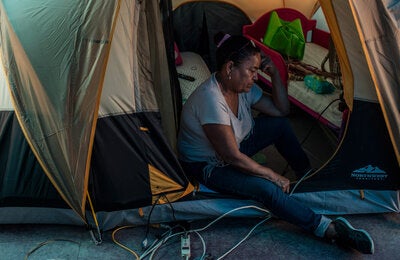
Washington, DC,October 21, 2016 (PAHO/WHO) - The Region of the Americas is celebrating 25 years with no cases of wild poliovirus. The last case was detected on August 23, 1991, in Peru. The countries of the region, supported by the Pan American Health Organization/World Health Organization (PAHO/WHO), were able to eliminate polio and maintain the Americas free of the disease by achieving high rates of vaccination coverage of children and through sustained epidemiological surveillance to ensure early detection of any outbreaks.
"Thanks to the strong commitment and hard work of the countries of the Americas, as well as health workers, donors, and other partners, poliomyelitis is now a fear that belongs in the past for parents in our region," said Cuauhtémoc Ruiz Matus, head of PAHO/WHO's Expanded Program on Immunization. "It is critical that we continue vaccinating so that polio disappears from the world. This is something we have been working toward for 30 years."
In 1975, nearly 6,000 cases of polio were reported in the Region, and in 1991 the last six cases were detected. Three years later, in 1994, the disease was formally declared eliminated from the region. Since then, no child has been paralyzed by polio in the Americas.
Poliomyelitis is a highly contagious disease caused by a virus that invades the nervous system and can cause paralysis in a matter of hours. It especially affects children under age 5. There is no cure, but it is preventable. When administered several times, the polio vaccine can provide lifetime protection. More than 15 million people around the world who are walking today would be paralyzed if not for vaccination.
In addition to providing technical assistance, PAHO has contributed to polio elimination by helping the countries of Latin America and the Caribbean procure most of the vaccines, syringes, and supplies they use in their immunization programs. The PAHO Revolving Fund has provided continuous supply and affordable prices with high quality standards.
As the first region of the world to eliminate polio, the Americas led the way toward a world free of the disease.
Today the world is close to achieving the goal of eradicating polio. Globally, there are now fewer cases than at any time in history: just 27 cases of wild poliovirus had been reported worldwide as of October 11 this year, compared with 51 cases in the same period last year. Only three countries detected polio cases in 2016: Pakistan, Afghanistan, and Nigeria, the latter reporting in August that two children had been paralyzed by the disease, after two years of no detected cases. Four of the six WHO regions have been certified as polio-free, and only one of the three types of wild poliovirus (type 1) continues to circulate in the world.
The efforts that resulted in these achievements were led by the Global Polio Eradication Initiative, headed by WHO, Rotary International, the United States Centers for Disease Control and Prevention (CDC), and UNICEF.
In April of this year, 155 countries and territories around the world took a step closer to eradication of the disease by taking part in "the switch," a process consisting of withdrawing trivalent oral polio vaccine (OPVt), which offered protection against the three types of poliovirus, and replacing it with bivalent vaccine (OPVb), which protects against two types, since poliovirus type 2 has been eradicated. This process will help strengthen the immunity of people vaccinated against the remaining types of poliovirus and reduce the risk of polio cases caused by the type 2 vaccine.
Global polio eradication will mean a disease-free world for future generations as well as economic savings of some $40-50 billion. Failing to meet the target of eradication would result in a reemergence of the disease, with an estimated 200,000 cases every year around the world. "There still is a great deal to do in this new push for global eradication to protect future generations and ensure that vaccines are available for all children," said Ruiz.
Regional efforts will now focus on ensuring that every year more than 95% of children under age 1 are vaccinated against polio in every municipality in the countries of the Americas. Efforts will also focus on increased monitoring of cases of acute flaccid paralysis and on meeting the requirements of the Global Polio Eradication Initiative and of the Polio Endgame Strategic Plan, which lays out the necessary steps for the world to be free of this disease by 2018.
Poliomyelitis was the second vaccine-preventable disease to be eliminated from the Americas (1994), preceded by the regional eradication of smallpox (1971) and followed by the elimination of rubella and congenital rubella syndrome (2015), and this year by the elimination of measles.



